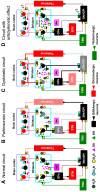The Interaction of Histamine H3 and Dopamine D1 Receptors on Hyperkinetic Alterations in Animal Models of Parkinson's Disease
- PMID: 39770568
- PMCID: PMC11679969
- DOI: 10.3390/ph17121726
The Interaction of Histamine H3 and Dopamine D1 Receptors on Hyperkinetic Alterations in Animal Models of Parkinson's Disease
Abstract
Parkinson's disease is associated with the loss of more than 40% of dopaminergic neurons in the substantia nigra pars compacta. One of the therapeutic options for restoring striatal dopamine levels is the administration of L-3,4-dihydroxyphenylalanine (L-Dopa). However, Parkinson's disease patients on long-term L-Dopa therapy often experience motor complications, such as dyskinesias. L-Dopa-induced dyskinesias (LIDs) manifest as abnormal involuntary movements and are produced by elevated striatal dopamine levels, which lead to increased activity of the basal ganglia direct striato-nigral pathway. Dopamine D1 receptors are more than 95% confined to neurons of the direct pathway, where they colocalize with histamine H3 receptors. There is evidence of functional interactions between D1 and H3 receptors, and here we review the consequences of these interactions on LIDs.
Keywords: D1 receptor; GABA; H3 receptor; L-Dopa-induced dyskinesias; Parkinson’s disease; cerebral cortex; dopamine; glutamate; histamine; striatum.
Conflict of interest statement
The authors declare no conflicts of interest.
Figures



Similar articles
-
Chronic administration of the histamine H3 receptor agonist immepip decreases L-Dopa-induced dyskinesias in 6-hydroxydopamine-lesioned rats.Psychopharmacology (Berl). 2019 Jun;236(6):1937-1948. doi: 10.1007/s00213-019-5182-y. Epub 2019 Feb 14. Psychopharmacology (Berl). 2019. PMID: 30762089
-
Chronic H3R activation reduces L-Dopa-induced dyskinesia, normalizes cortical GABA and glutamate levels, and increases striatal dopamine D1R mRNA expression in 6-hydroxydopamine-lesioned male rats.Psychopharmacology (Berl). 2023 Jun;240(6):1221-1234. doi: 10.1007/s00213-023-06339-1. Epub 2023 Apr 22. Psychopharmacology (Berl). 2023. PMID: 37086286
-
Evidence that L-dopa-induced rotational behavior is dependent on both striatal and nigral mechanisms.J Neurosci. 1989 Sep;9(9):3326-31. doi: 10.1523/JNEUROSCI.09-09-03326.1989. J Neurosci. 1989. PMID: 2795165 Free PMC article.
-
Expanding the repertoire of L-DOPA's actions: A comprehensive review of its functional neurochemistry.Prog Neurobiol. 2017 Apr;151:57-100. doi: 10.1016/j.pneurobio.2016.07.002. Epub 2016 Jul 4. Prog Neurobiol. 2017. PMID: 27389773 Review.
-
Application of the concept of continuous dopaminergic stimulation for the management of Parkinson's disease.Neurosci Bull. 2013 Oct;29(5):661-9. doi: 10.1007/s12264-013-1329-8. Epub 2013 Mar 20. Neurosci Bull. 2013. PMID: 23512740 Free PMC article. Review.
References
Publication types
LinkOut - more resources
Full Text Sources
Miscellaneous

